Epidural - series
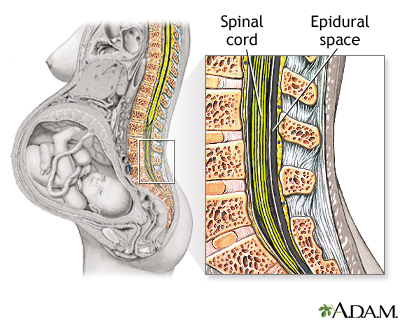
Procedure, part 1
Your understanding of what happens during labor and delivery as well as your attitude toward it, affect the amount of pain you feel while giving birth. The breathing methods and relaxation techniques you learn in childbirth-education class may reduce your need for pain medication, but you won't know whether you'll need drugs until you're in the delivery room.
The most common form of pain medication used in labor is an epidural block. During the procedure, anesthetic is injected into the epidural space near your spinal cord, temporarily numbing your lower body.
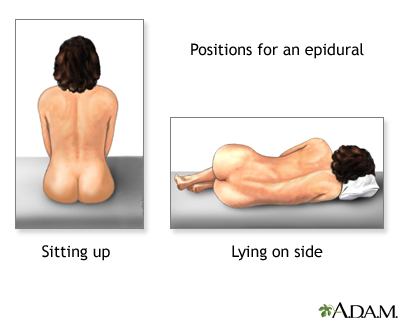
Procedure, part 2
An epidural usually causes little discomfort and is administered while you are sitting up or lying on your side, with your back curved outward.
After you receive the epidural, your caregiver will closely monitor your blood pressure, heart rate, and your baby's heart rate.
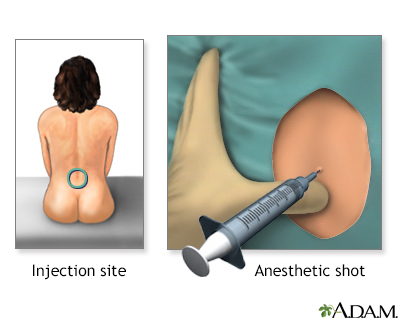
Procedure, part 3
Before you get an epidural, your doctor will wash your back with antiseptic and determine the best place for the injection. Next, you'll get a shot of local anesthetic to numb the spot where the epidural needle will be inserted.
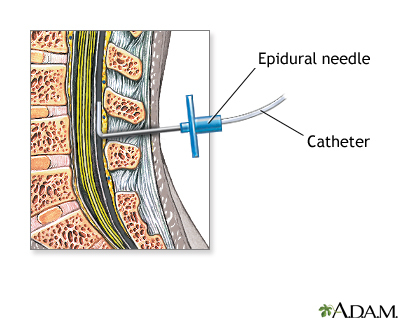
Procedure, part 4
The doctor will carefully insert an epidural needle between your vertebrae, thread a hollow tube through the needle, and remove the needle, leaving the catheter in place. Anesthetic is then administered through the catheter.
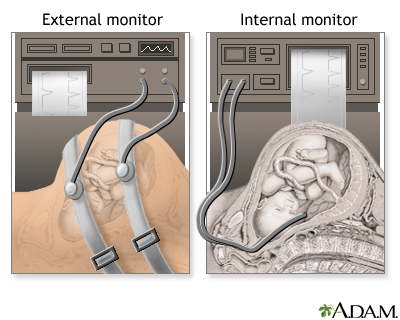
Procedure, part 5
Epidurals are very effective at relieving labor pain, but they have some drawbacks: First, they take up to 20 minutes to administer and take effect. Epidurals can slow labor if they're given too soon, and being numb from the waist down may make it harder for you to push your baby out. Unless you are given a "walking epidural" or "narcotic spinal", you'll need to stay in bed for your entire labor.
Epidurals can also cause your blood pressure to drop, which in turn may slow your baby's heartbeat. To prevent this, you'll be given intravenous fluids and may be asked to lay on your side to help your blood circulate. To be on the safe side, your doctor will keep close tabs on your baby by continuously monitoring your blood pressure and his heart rate.
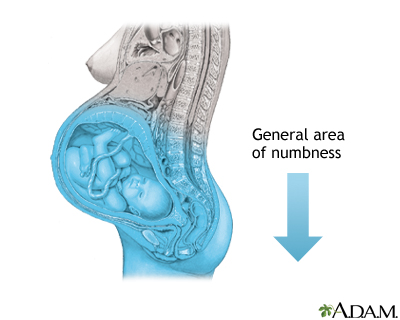
Procedure, part 6
The major benefit of having an epidural is that you can remain awake, alert, and almost totally pain-free while actively participating in your baby's birth. You can also relax and conserve your energy during a long labor. To lower the odds of side effects for you and your baby, your doctor will likely give you the lowest effective dose.
BACK TO TOP
Review Date: 4/19/2022
Reviewed By: John D. Jacobson, MD, Department of Obstetrics and Gynecology, Loma Linda University School of Medicine, Loma Linda, CA. Also reviewed by David C. Dugdale, MD, Medical Director, Brenda Conaway, Editorial Director, and the A.D.A.M. Editorial team.

Health Content Provider
06/01/2025
|
A.D.A.M., Inc. is accredited by URAC, for Health Content Provider (www.urac.org). URAC's accreditation program is an independent audit to verify that A.D.A.M. follows rigorous standards of quality and accountability. A.D.A.M. is among the first to achieve this important distinction for online health information and services. Learn more about A.D.A.M.'s editorial policy, editorial process and privacy policy. A.D.A.M. is also a founding member of Hi-Ethics. This site complied with the HONcode standard for trustworthy health information from 1995 to 2022, after which HON (Health On the Net, a not-for-profit organization that promoted transparent and reliable health information online) was discontinued. |
The information provided herein should not be used during any medical emergency or for the diagnosis or treatment of any medical condition. A licensed medical professional should be consulted for diagnosis and treatment of any and all medical conditions. Links to other sites are provided for information only -- they do not constitute endorsements of those other sites. © 1997- 2024 A.D.A.M., a business unit of Ebix, Inc. Any duplication or distribution of the information contained herein is strictly prohibited.
